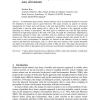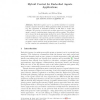112 search results - page 5 / 23 » Power and the limits of reactive agents |
ICDCS
2011
IEEE
12 years 6 months ago
2011
IEEE
Abstract—Intentional interference constitutes a major threat for communication networks operating over a shared medium where availability is imperative. Jamming attacks are often...
CONNECTION
2004
13 years 6 months ago
2004
In autonomous agent systems, internal memory can be an important element to overcome the limitations of purely reactive agent behaviour. This paper presents an analysis of memory r...
ICHIM
2001
13 years 8 months ago
2001
Traditional visits to environments interesting from a cultural point of view are based on technologies that do not permit flexibility and modification to the visit itself on the b...
ATAL
2000
Springer
13 years 11 months ago
2000
Springer
Abstract. Dyna is a single-agent architectural framework that integrates learning, planning, and reacting. Well known instantiations of Dyna are Dyna-AC and Dyna-Q. Here a multiage...
KI
2009
Springer
14 years 1 months ago
2009
Springer
Embodied agents can be a powerful interface for natural human-computer interaction. While graphical realism is steadily increasing, the complexity of believable behavior is still h...


